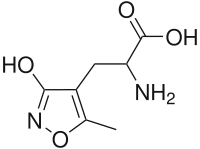AMPA
 |
|
| Names | |
|---|---|
|
IUPAC name
2-Amino-3-(3-hydroxy-5-methyl-isoxazol-4-yl)propanoic acid
|
|
| Identifiers | |
|
74341-63-2 |
|
| 3D model (Jmol) | Interactive image |
| ChEMBL |
ChEMBL276815 |
| ChemSpider |
1184 |
| DrugBank |
DB02057 |
| 4131 | |
| KEGG |
C11033 |
| MeSH | AMPA |
| PubChem | 1221 |
|
|
|
|
| Properties | |
| C7H10N2O4 | |
| Molar mass | 186.17 g·mol−1 |
|
Except where otherwise noted, data are given for materials in their standard state (at 25 °C [77 °F], 100 kPa).
|
|
|
|
|
| Infobox references | |
AMPA (α-amino-3-hydroxy-5-methyl-4-isoxazolepropionic acid) is a compound that is a specific agonist for the AMPA receptor, where it mimics the effects of the neurotransmitter glutamate.
There are several types of glutamatergic ion channels in the central nervous system including AMPA, kainic acid and N-methyl-D-aspartic acid (NMDA) channels. In the synapse, these receptors serve very different purposes. AMPA can be used experimentally to distinguish the activity of one receptor from the other in order to understand their differing functions. AMPA generates fast excitatory postsynaptic potentials (EPSP). AMPA activates AMPA receptors that are non-selective cationic channels allowing the passage of Na+ and K+ and therefore have an equilibrium potential near 0 mV.
...
Wikipedia
